August 14, 2009
Air Date: August 14, 2009
FULL SHOW
SEGMENTS
Honey Laundering
View the page for this story
The tale of honey is not all sweet. In an eight part investigative series in The Seattle Post-Intelligencer, reporter Andrew Schneider looks at the origins of imported honey and the lack of oversight by federal agencies. Schneider tells host Bruce Gellerman that Chinese honey makes up about a third of honey consumed in the U.S. and, he says, some of it is watered down with corn syrup and contains antibiotics illegal here. (05:30)
Why Tropical Forests Fall
View the page for this story
Tropical forest is disappearing in Africa’s Congo Basin, in Southeast Asia, and in the Amazon. The reasons for the bulldozing and burning of trees vary by region. Living on Earth’s Ingrid Lobet has this primer. (06:00)
Clean Water for Kenya
/ Jessica PartnowView the page for this story
In Kibera, a slum of Nairobi, Kenya, clean water is too scarce. But a new technology that takes just a plastic bottle and six hours in the sun is helping reduce sickness and diarrhea in the community, and in other developing countries around the world. Jessica Partnow reports. (07:35)
After War, Wind-Powered Radio
View the page for this story
In Southern Sudan, electricity is virtually non-existent after 22 years of civil war. Host Bruce Gellerman talks with Internews program director Deborah Ensor about bringing solar and wind energy to the region to power a new radio station. (07:30)
Last Bat Home
/ Verlyn KlinkenborgView the page for this story
Commentator Verlyn Klinkenborg watches the bats of dawn return to their roost and finds himself wanting to adjust to their schedule. (02:45)
Ode to Powerlines
/ Ike SriskandarajahView the page for this story
Power lines give a pulse to the American landscape. So say cartographer Brian Rosa and photographer Adam Ryder who walked, camped, and lived in the shadow of Rhode Island’s power lines to try to understand how they impact the environment and people. Producer Ike Sriskandarajah uncovers how the ubiquitous pylons and lines capture the imagination. (6:15) (06:00)
Note on Emerging Science
/ Alexandra GutierrezView the page for this story
Living on Earth's Alexandra Gutierrez reports that female topi antelopes defy typical animal behavior patterns and aggressively pursue their male mates. (01:30)
Woman's Best Friend
View the page for this story
Wesley the barn owl spent his life as the cherished companion of wildlife biologist Stacey O’Brien. O’Brien chronicles their nineteen years together in her book, “Wesley the Owl; The Remarkable Love Story of an Owl and His Girl.” (10:20)
This week's EarthEar selection
listen /
download
Listen to the sounds of moose frolicking in the waters of a Wasatch Mountain lake in Utah.
Show Credits and Funders
Show Transcript
Host: Bruce Gellerman
Guests: Andrew Schneider, Martin Stutsman, John Mussa, Deborah Ensor, Stacey O’Brien
Reporters: Ingrid Lobet, Jessica Partnow, Ike Sriskandarajah
Commentator: Verlyn Klinkenborg
Note: Alexandra Gutierrez
EarthEar: Jeff Rice
[THEME]
GELLERMAN: From Public Radio International—this is Living on Earth.
[THEME]
GELLERMAN: I’m Bruce Gellerman. Federal agencies are stunned by allegations they’re not guarding the national honeypot.
SCHNEIDER: Neither the FDA nor the USDA has a legal definition of honey. Which means that enforcing the quality of honey becomes extremely difficult.
GELLERMAN: How sweet it isn’t. Coming up: honey laundering. Also, African deforestation and climate change.
MAATHAI: Because communities do not have an understanding of how to use the land sustainably, prevent soil erosion, when you fly over Africa, you see a lot of that slash and burn, especially within the Congo Basin forest.
GELLERMAN: And a couple of live wires pay homage to high-tension power lines.
[ELECTRIC BUZING]
GELLERMAN: This electrifying story, and more, this week on Living on Earth. Stay plugged in.
[THEME]
Honey Laundering

(Photo: Scott Bauer, USDA/ARS)
GELLERMAN: From the Jennifer and Ted Stanley Studios in Somerville, Massachusetts, this is an encore presentation of Living on Earth. I’m Bruce Gellerman. Americans have a sweet tooth for honey. We eat over a pound of honey per person a year. Honey is healthy and the stuff of sweet dreams - a major ingredient for Winnie the Pooh bedtime stories.
But just as Pooh got stuck digging deep into a honey pot, last spring West Coast importers got stung when a federal SWAT team swooped down and busted them for honey trafficking.
Andrew Schneider was a senior correspondent for the Seattle Post-Intelligencer when he investigated honey imports. And his eight part series read more like James Bond than Pooh Bear.
SCHNEIDER: We have a problem in this country – we only make about a third of the 450 million pounds of honey that we consume. The rest comes in across our borders. It's called trans-shipping
GELLERMAN: So we're consuming a lot. And a lot of that, you write, comes from China. I guess about half of the remaining imports.
SCHNEIDER: Yeah, that's pretty much what we figured out. They're most often marked as coming from other countries: Vietnam, Korea, India, Australia. But in most cases they are from China, and just illegally relabeled.
GELLERMAN: You have a great turn of a phrase – you call it honey laundering. And I guess the honey that we get from China is supposed to have a tariff. So what these companies do is they send it off to another country and label it coming from that country when it's really coming from China.
SCHNEIDER: Right, you've defined honey laundering very well, Bruce. They avoid the tariffs by shipping it to a country that has no tariffs. And they also avoid the added scrutiny that's often applied to Chinese honey, because Chinese honey has been found to be contaminated over the years with antibiotics that the FDA declares illegal.
GELLERMAN: When honey enters the United States from China or from anyplace else, isn't it tested for safety?
SCHNEIDER: It depends who you ask. The closer that we got to the headquarters of FDA and the Immigrations and Customs Enforcement Agency, the more people were insisting that they inspect every shipment of honey.
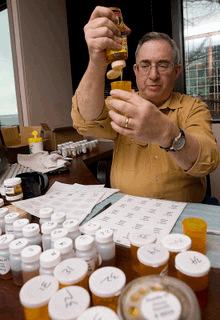
Andrew Schneider taking samples of honey for his investigative series for the Seattle Post Intelligencer (Photo: Seattle Post Intelligencer)
GELLERMAN: Well what about the importers, the companies that actually, you know, purchase the honey in volume and then sell it over here. Don't they test their own products?
SCHNEIDER: Not so much. Rarely, actually. One of the things that's really gotta be understood is regardless of how sinister or criminal the Chinese honey shippers may be, they couldn't get their honey into this country unless there were people here that were willing to close their eyes and make believe that it's not from China. I mean, it's pretty obvious. The going price for good honey, from Canada, for example, might be a buck sixty a pound. Australian honey might be a buck forty a pound. If all of a sudden, as a honey packer, you're being offered three hundred thousand pounds of honey at fifty cents a pound, wouldn't you think you might wonder a bit about why you're getting such a great price?
GELLERMAN: Well we've been talking about honey, and one of the things you write about in your article is that actually, there is no legal definition of what honey is in this country.
SCHNEIDER: That's correct. Neither the FDA nor the USDA has a legal definition of honey. Which means that enforcing the quality of honey becomes extremely difficult and problematic.
GELLERMAN: What about the labeling where it says organic?
SCHNEIDER: Well, if it says “made in the U.S. organic honey,” the chances are almost totally that they are wrong. Mainly because you can't control where the bees fly. Now that doesn't mean there isn't organic honey.
There are parts of South America that are totally undeveloped. There are parts of Northern Canada that have no commercial farming whatsoever, and there is organic honey coming from those places, but if it says made in the U.S.A. organic, I'd be very suspicious of it.
GELLERMAN: Do you like honey?
SCHNEIDER: I liked it a lot more before I started researching this story.
GELLERMAN: Investigative reporter Andrew Schneider's eight part series about imported honey appeared in the Seattle Post Intelligencer. We contacted Martin Stutsman of the Food and Drug Administration and he confirmed the government does test only about 100 barrels of imported honey a year.
STUTSMAN: Honey is a low-risk commodity. We don't have a lot of problems with honey.
GELLERMAN: Why is there no legal definition of honey? I understand that you can actually put sugar water or fructose in a plastic bear and call it honey because there is no regulation.
STUTSMAN: We don't have a regulation specifying what honey is. But honey is commonly understood to be the material produced by bees from nectar of flowers and deposited and dehydrated by the bees in the honeycomb.
GELLERMAN: And Martin Stutsman says the FDA has and does cite packagers who mix fructose with honey.
Related link:
To read Andrew Schneider’s 8 part series on honey, click here.
[MUSIC: Emily Remler “A Taste Of Honey” from “Firefly” (Concord Jazz 1988)]
Why Tropical Forests Fall
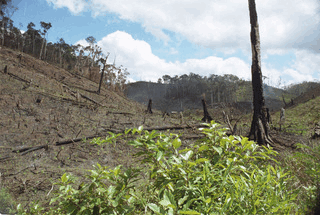
GELLERMAN: Tropical forests cover about seven percent of the Earth’s surface, but cutting and burning of trees releases about twenty percent of climate change emissions. That’s why experts in deforestation and rural development are working with climatologists to make sure that the next international climate treaty protects the world’s tropical forests. We have this report from Living on Earth's Ingrid Lobet about the forces driving tropical deforestation.
LOBET: Even some veteran environmentalists have been startled to realize how much the cutting and burning of tropical forests is responsible for global warming.
MAATHAI: For me, that was amazing.
LOBET: That's Nobel Laureate Wangari Maathai. The tree-planting movement founder spoke at recent climate change talks in Poznan, Poland.
MAATHAI: Because quite often, we in the developing world, we say that we are not contributing much to greenhouse gases. But obviously if you take into account deforestation, land degradation, the fact that the majority of people use wood—firewood—for their lighting and cooking, then obviously they are releasing a lot of greenhouse gases into the atmosphere, far more than I'm sure people are aware of.
LOBET: In Africa, Maathai says, it's often villagers who cut the forest to plant crops.
MAATHAI: And because communities do not have an understanding of how to use the land sustainably, prevent soil erosion, when you fly over Africa, you see a lot of that slash and burn, especially within the Congo Basin forest.
LOBET: The Congo Basin forest is second in size only to the Amazon. So preserving it is among the highest priorities of tropical forest experts. Dennis Garrity directs the World Agroforestry Centre or ICRAF, a group with deep tree-planting roots in Africa.
GARRITY: Agriculture is largely responsible for deforestation. And some estimates say that 80 percent of forest conversion is directly related to producing more food.
LOBET: Besides food, another major cause of deforestation in Africa's Congo Basin, says Garrity, is the production of furniture grade wood.
GARRITY: The world is going to have to produce that enormous quantity of wood supply in other ways. Otherwise the sheer demand for wood will swamp any attempts to forestall deforestation.
LOBET: Experts say much of each tall tree cut for furniture wood is left on the ground. On a recent tour of one sustainable timber operation, Wangari Maathai says managers told her their machinery only allowed them to take advantage of 35 percent of the wood they fell.
MAATHAI: The rest is actually taken by local communities and converted into charcoal. That, to me, is just as good as putting the forest on fire.
LOBET: Even without fire, the trees will release carbon as they decay on the forest floor. The carbon release speeds up when they're roasted for charcoal, and any remaining carbon is released when that charcoal is burned.
That's in Africa. But the reasons for deforestation differ sharply across the tropics. Lars Lovold, director of Rainforest Foundation Norway, has worked with indigenous people in forests for 30 years.
LOVOLD: We have all heard from official sources, blaming deforestation on the poor. It is not true. It is the large-scale investments, in oil palm for Asia, in cattle for Central and South America, in industrial agriculture taking over from cattle in South America, timber plantations on many continents that really drives deforestation on a large scale.
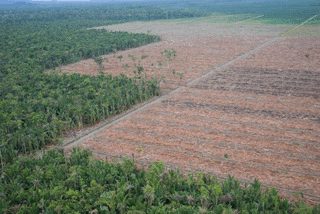
Forests cleared to make way for palm oil plantations in Papua Province, Indonesia. (Photo: Courtesy of Greenpeace Southeast Asia)
CHOMITZ: Much of the world's tropical deforestation is concentrated in a few areas in the Brazilian frontier and also in Indonesia. And what we know about Brazil suggests that a lot of the clearing in Brazil is done in large chunks: we're talking a thousand, two thousand acres at a time, which is far too big to be accomplished by anybody but a large industrial interest with bulldozers and machinery.
LOBET: In Indonesia, the other major site of tropical tree-razing, the bulldozers are paid for with profits from palm oil, squeezed from the fruit and seeds of the oil palm, grown on plantations.
CHOMITZ: You'll find palm oil in a lot of the processed foods you eat.
LOBET: And in cosmetics, as well. Environmental groups say even people's efforts to make positive changes, for example: avoid transfats... or use biodiesel, are turning forests into palm plantations.
Not only do the reasons for deforestation differ by region, but professionals collaborating on the issue also tend to view it through the lens of their training: as economists, agronomists, environmentalists, and government officials. Here's how Virgilio Viana, former environmental minister for the world's largest tropical forest state, Amazonas, sees it:
VIANA: The most important driver of deforestation in tropical countries is poor governance.
LOBET: Meaning: who owns the forest and who's responsible for protecting it.
And as climate change negotiators prepare for the Copenhagen talks in December, they'll need to take into account all these reasons for deforestation - if the world hopes to eliminate this fifth of the planet's emissions.
For Living On Earth, I'm Ingrid Lobet.
Related links:
- To learn about reforestation and international climate change negotiations, click here.
- For more on efforts to slow deforestation, click here.
- To hear a story about deforestation on Borneo, click here.
- For more on how deforestation has affected Haiti, click here.
- To learn about the role soybeans play in deforestation in Brazil, click here.
[MUSIC: Andrew Bird “The Tree Were Mistaken” from “Soldier On” (Wegawam Music 2006)]
GELLERMAN: Coming up—a simple solution for clean water: plastic bottles and sunlight. Keep listening to Living on Earth.
Clean Water for Kenya
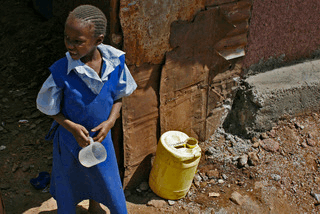
Kibera resident with empty cup and jerry-can for collecting water. A 20 liter jerry-can costs about five cents to fill. The average family uses between five and seven of these per day. (Photo: Alex Stonehill)
GELLERMAN: It’s an encore edition of Living on Earth. I’m Bruce Gellerman. Kibera, in Nairobi, Kenya, is one of the world's largest slums. It's home to about a million people, and many grinding social problems - violence, poverty, unemployment.
But perhaps the biggest threat to Kibera's residents is the lack of sanitation and clean water. Shortages and contamination have brought diseases and death to the people in the Kenyan slum. But residents are fighting back with a simple, low-cost solution, as Jessica Partnow now reports.
[SCHOOLYARD WITH KIDS PLAYING]
PARTNOW: At the Stara Primary School in Kibera, students play in the shadow of a towering water tank. Their footsteps kick up clouds of red dust, which hang in the humid air. Mary Muthini, who's better known as Teacher Mary, runs the school.
MUTHINI: This school was started in the year 1999 with around six children, who were orphans. Initially we started a feeding program, but then the vision of educating them came into our mind and we thought of, as much as we feed them, we should also be educating them.
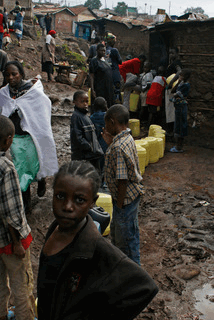
Kibera residents stand in line to buy water from a vendor. Because of interruption in the water supply, lines can sometimes be hours long. (Photo: Alex Stonehill)
Nariobi's water reaches the outer edge of the Kibera settlement. From there, water flows through a network of low quality PVC pipes into the 25 hundred-gallon water tanks that dot the streets.
Much of the water supply is controlled by private vendors, who charge Kibera residents over ten times more than high-income residents of Nairobi, and sometimes create artificial water shortages.
And that's for water that isn't always clean. The pipes break frequently, exposing the water to sewage.
Again, Teacher Mary.
MUTHINI: We had so many cases of waterborne diseases. Such like typhoid, cholera, dysentery, just to mention but a few.
PARTNOW: In 2007 the UN Development Program reported that six in ten infants in Kibera die of waterborne diseases before the age of 18 months.
For residents surviving on less than a dollar a day, paying for fuel for boiling or for chlorine tablets, on top of the price for the water itself, is out of reach.
[STREAM FLOWING, MUSIC, KIDS]
PARTNOW: At a riverbank behind the school sit piles of garbage alongside tin houses and tangled barbed wire. The river here doubles as an open sewer.
[OUTDOOR SOUNDS, BABY CRYING, LAUGHTER]
PARTNOW: Thirty year old Habiba Mohamed grew up in Kibera. A black headscarf frames her face. And a flash of gold sparkles from a front tooth as she speaks.
MOHAMED: You see, a toilet facility like this one can be used by more or less a thousand people because...
PARTNOW: She points to an outhouse shared by a thousand people and says rather than stand in line, many residents prefer to use a Flying Toilet. Also known as a plastic bag.
MOHAMED: Like here you can find most of the garbage here – if you had the guts to look – most of it is feces.
PARTNOW: Mohamed works for the internationally funded Kenya Water for Health Organization. She goes door to door trying to convince her neighbors to treat their drinking water using Solar Water Disinfection, also known as SODIS. It's a low-tech approach to cleaning water.
OTIENO: So, this is one way of treating water - drinking water - at the household level, using UV light.
PARTNOW: That's Joseph Otieno, Kenya Water for Health's SODIS project officer. He says all you need is a clear soft plastic bottle.
OTIENO: So you, the first time you get this bottle you clean it. Then you fill it with water, then you close it tightly. Then you expose the bottle to the sun for a minimum of six hours.
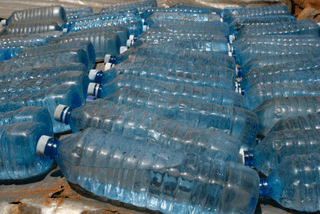
Plastic bottles filled with water and placed on corrugated metal in the sun are a common site in the Makina area of Kibera. (Photo: Alex Stonehill)
SODIS was developed in Switzerland and is now used by two million people in Latin America, Africa and Asia. Test after test has shown SODIS produces sanitized water that easily meets World Health Organization guidelines.
OTIENO: We always test our water so that we can assure the community that the water is clean, it is safe, for drinking.
PARTNOW: Some find it hard to believe that SODIS actually works. Habiba Mohamed says she's even had doors slammed in her face.
MOHAMED: Yeah it happens! You come they say "Ah, they are coming!" whoof! They bang the door. They refuse if from the first day and that remains. And I wish they would refuse it and have an alternative. But they refuse it arrogantly: "I've been taking this water for the past 50 years. Who are you to change me now?"
PARTNOW: But Kenya Water for Health reports that 250,000 Kibera residents are now using SODIS. There has been a 20% decrease in diarrhea cases since the program’s inception in 2004, and a shrinking need for costly hospital visits.
Teacher Mary saw an immediate change in the health of her students.
MUTHINI: When SODIS came in, we actually observed a high reduction of the waterborne diseases. That is we had no more complaints, no more pupils coming to complain about waterborne diseases any more.
STUDENTS: SODIS, OH SODIS. Safe water. It is easy to make. Just get a bottle, plus the sun! And your water will be treated. SODIS! How wonderful it is!
PARTNOW: Teacher Mary's students know all about SODIS. The idea is that children will encourage their parents to use the solar bottles, as well as use them themselves.
But while it's clear SODIS is making a difference, Habiba Mohamed is quick to point out that it's not a perfect solution.
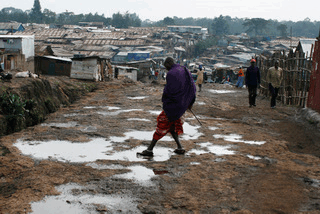
A Masai man washes his sandals in puddles from the previous night's rainstorm. It’s estimated that 60 percent of Nairobi's residents live in slums like Kibera on the city's outskirts. (Photo: Alex Stonehill)
MOHAMED: Just as long as they don't take the water like it is. Because we now understand that we've a bit tried to take people from taking raw water, to make sure they take a step of improving their water. Because water is life, at the same time water is death.
STUDENTS: Water is important in our life. We need water to drink, cook and so on. Remember: good health depends on clean water. And that is SODIS. How wonderful it is!
PARTNOW: For Living on Earth, I'm Jessica Partnow in Kibera, Kenya.
STUDENTS: …from waterborne diseases like cholera…
[STUDENTS CONTINUE CHANTING; CLAPPING]
GELLERMAN: Our report on Kibera's drinking water was funded by the Pulitzer Center on Crisis Reporting. For more information about the project, check out our website - loe.org.
Related links:
- Solar Water Disinfection (SODIS)
- Check out a multimedia feature on clean water in Kibera.
After War, Wind-Powered Radio
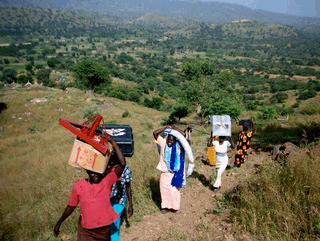
Local women carry supplies to a new transmission tower at the top of Kauda Mountain. (Courtesy of Internews)
[SOUND OF RADIO MUSIC BROADCAST]
GELLERMAN: From one of the most remote places on the planet, a familiar sound – radio - a critical link, empowering the people of southern Sudan.
[SUDAN RADIO: This is the voice....[foreign language] This is your community radio.]
GELLERMAN: For more than two decades southern Sudan was the scene of one of the longest and bloodiest wars of the 20th century. Before it ended four years ago, nearly two million civilians were killed and four million southerners were forced to flee their homes.
Now many are returning and radio is helping to heal the nation. John Mussa is a reporter with Internews in southern Sudan. Internews is an international nonprofit organization that works to improve access to information for people around the world by fostering independent media.
MUSSA: Nuba Mountain is a part of Sudan. It has never seen a development before and after independence of Sudan. It was the dream of a number of people to have radio. Because it's a simple way to give a message.
GELLERMAN: In Sudan, Internews built four radio stations in the war-torn south, and uses sustainable, renewable energy to power them.
Deborah Ensor is Internews's program director in Sudan.
ENSOR: Since the war ended in south Sudan, there's no real infrastructure here, there's no way for people to get information. There's not a lot of printing presses, there's not a lot of newspapers. A lot of people can't read because there hasn't been schools in south Sudan for many, many years. So radio is a really great way to reach people.
GELLERMAN: Radio is a really powerful medium, but how do you get power for your radio stations?
ENSOR: As I was saying earlier, there is no infrastructure in south Sudan or very limited infrastructure. Which means there's no electricity. So everything is powered by generators, and generators are expensive and they're somewhat difficult to maintain. So in some of our stations we use solar and wind power. Sudan is a very hot place. It's very dry half of the year, and so the sun is a really, really great way to power some of the stations.
GELLERMAN: Some of these radio stations are located in incredibly remote mountainous regions.
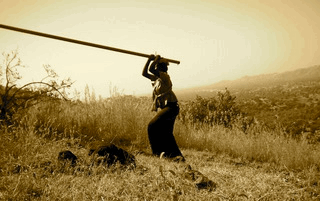
A local woman carries part of a windmill up a Kauda mountain to power her local radio station.(Courtesy of Internews)
Getting it up there was a whole 'nother matter in and of itself. We had over a ton of equipment that had to go on the top of this mountain, including six batteries that weigh about 60 kilograms apiece, four mast sections, more than 50 kilograms of tools, every day that had to go up and down. It's like a 90-minute hike to get up the hill. The temperature is 105, 110 degrees. And there's no vehicles that can go up there. So we hired a lot of local women from the community. They carried up all of the equipment - something like 20 kilos per load on their heads.
And it's amazing. I would go up this hill and I would be so plum tuckered by the time I got up there and I'm not even carrying anything, but myself and a bottle of water, you know. And these women are carrying 20 or 30 kilos on top other their head and they're walking barefoot or in sandals, and they're laughing and singing along the way, and it was very easy for them.
GELLERMAN: Deb, why women? Didn't the men do this?
ENSOR: You know the men did other jobs. The men carried the batteries because it took four men to carry one battery because they're so heavy. But generally speaking, women do a lot of the work.
GELLERMAN: You sent us some audio from going up this mountain. Let's listen to it now.
DOBBING: We're just approaching the roof of the community mast on top of the mountain.
ENSOR: This is Ellie Dobbing. She's our media training manager.
DOBBING: We've walked up to look at it. [Panting] You can hear the wind turbines spinning. [Walking]
ENSOR: Well, from this remote transmission site it's 100 percent solar and wind power, because it is way on the top of this mountain and there's no other way to get any kind of source of energy up there. The station itself which is down at the bottom of the mountain – about 50 percent of it is operated with solar panels and the other 50 percent is backed up with a generator.
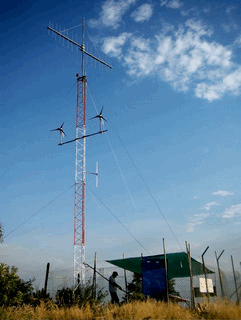
This transmission tower had to be located at the top of Kauda Mountain to broadcast to a larger local audience. (Courtesy of Internews)
ENSOR: There's several NGOs that give out radios as part of their projects and they are these terrific little solar powered and hand crank radios.
GELLERMAN: I understand you have a problem with roaming cows and goats affecting the station. How's that?
ENSOR: [Laughs] Yeah, well, you know, all of these areas are agricultural areas. Everyone has cows, everyone has goats. They sort of just free roam anywhere and [laugh] you're trying to record on the air and you can hear in the background the bleating of goats, you know, the feet of cows padding by. So you have to be very careful when you're setting up sensitive equipment to make sure that it's fenced off very well so that roaming animals don't destroy it by accident.
GELLERMAN: Deb, this is community radio that you're doing, this is run by the people who live there. Have they ever done community radio, or any radio?
ENSOR: Yeah, it is community radio. And that's what's so fantastic about this project, right? It's like you go to these communities and people there are not journalists, you know, they're farmers, they're teachers, they're people who have been relocated after the war, they're just returning home after years of being away in refugee camps or being in another country, so it's just fantastic.
They have this interest in helping their communities and in helping in peace and reconciliation in their communities by giving information, so we train them completely from scratch. How to open the computer, how to turn it on, how to get audio, how to edit, how to interview. It's just amazing when you hear the output.
[SUDAN RADIO: FOREIGN LANGUAGE, DRUMMING]
ENSOR: The communities are just thrilled with these stations, you know, they're so excited to hear them. It's fantastic, just the enthusiasm and the excitement for people to be able to hear radio and to hear it in their own language. We broadcast in more than ten different languages.

One hundred percent of the power for the Kuada station’s transmission tower comes from sun and wind, while the radio station in the valley uses solar panels, backed up with generators. (Courtesy of Internews)
ENSOR: It provides them with information about so many things, things like early marriage and why is it important for young girls to stay in school, you know, if there's a malaria outbreak, the station informs what to do and where it's happening. And it does a lot of really funny, great, wonderful little things too. You know, they have these community hours where people in the community can just come to the station and make announcements on the air. They talk about their lost cows, they come in to sing folk songs, and they just really grasp on to it and really participate.
GELLERMAN: I've consulted with Internews overseas and I've worked with them with setting up radio stations around the world. Where does it go from here, Deb?
ENSOR: What we're trying to do is to build the capacity of the staff and of the community to be able to run the station on their own. The idea is that at the end of the day Internews will leave and these stations will remain behind and there'll be a cadre of journalists that are able to put together accurate and fair and interesting information for their communities and that they can do it on their own.
GELLERMAN: Deborah, thanks a lot. Appreciate it.
ENSOR: Thanks a lot, Bruce. I appreciate it too.
GELLERMAN: Deborah Ensor is Program Director for Internews in Sudan, where the wind and sun are powering radio stations and empowering people.
[PEOPLE SINGING ON THE RADIO]
Last Bat Home
GELLERMAN: Bats often get a bad rap. But not from Verlyn Klinkenborg, who finds comfort in the flying creatures of the night.
KLINKENBORG: It's 6:00am, a dark gray morning in late summer, the dim light a reminder that it's two months on the downhill side of the season. Ethel the border terrier and I are behind the house, investigating a woodchuck's scent. There is a dark smudge in the mist above us, and then another.
The bats are returning to their bat house – a thin, slatted box high up under the eaves. Each bat comes in over the roof, makes a dive for the ground and then swoops upward toward the narrow entrance of the bat-house. Some slip inside on the first try, some fall back and try again. After a few minutes, the air is still, the last bat home. Ethel and I turn toward breakfast.
I have seen the bats come out at evening again and again. It is one of the joys of living here, watching them drop one by one into the night. But I've seen them coming home only a few times. The bats of evening are the last flutter in a world that’s growing still. The bats of morning have already been engulfed by birdsong, rooster-crow, the stirring of nearly every creature on this place. Their flight is less erratic just before roosting, no longer distracted by an insect in the air. It's as though each bat brings a scrap of night's darkness home with it, leaving the sky pale and brightening. It's as though night itself were being stored in the bat-house till dusk.
When the last bat had vanished, I felt almost absurdly alone, strangely vacant in that thin slice of morning. It reminded me of a feeling from a long time ago – that moment, after staying up all night, when you can feel the world gathering pace and energy just as you're beginning to fade, the city stirring, streets coming to life, a crescendo that grows and grows. You can almost pinpoint the moment when the city reaches full throttle. You glimpse, from outside, barely awake, what a powerful movement morning really is. There is no coaxing about it. It marches you right into the day, right through life.
Watching those dawn bats, I imagined them punching out of their night's work as they settled, and I felt as if I'd somehow clocked into their schedule. Really, the best use of a dark gray morning with mist in the air is to go back to bed, only a few feet – and a couple of walls – away from where the bats are sleeping.
[MUSIC: Tom Verlain “Mountain” from “Around” (Thrill 2006)]
GELLERMAN: Verlyn Klinkenborg writes editorials for the New York Times and lives on a farm in New York State.
Coming up—things that go bump in the night. An owl and a biologist. A love story. It’s a hoot. Stay tuned to Living on Earth.
Ode to Powerlines
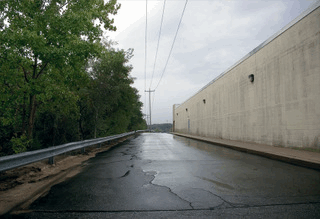
(Photo: Brian Rosa)
GELLERMAN: It’s an encore edition of Living on Earth. I’m Bruce Gellerman. High-tension transmission lines carry the current that powers the country. Typically the giant towers and cables get no respect as we buzz by in our cars paying them no mind, but Living on Earth’s Ike Sriskandarajah found two live wires who love the lines, and has our story.
SRISKANDARAJAH: So these two guys – a cartographer ...
ROSA: My name is Brian Rosa.
SRISKANDARAJAH: ...and a photographer ...
RYDER: My name's Adam Ryder
SRISKANDARAJAH: ... have been fascinated by power lines from a very young age.
RYDER: I spent a long time in the car with my parents on really long car rides, and I was an only child, so I would be looking out the window a lot.
SRISKANDARAJAH: Looking out the window, Brian and Adam both noticed these gently undulating curvy lines.

“….back to my teenage years a little bit.” (Photo: Brian Rosa)
[MUSIC: "I DON'T HAVE TO TRY. I DON'T HAVE TO SPEAK. I CAN WATCH THE COUNTRY SIDE." THE SOUND OF A CAR STARTING. MUSIC: "AND I CAN FALL ASLEEP"]
SRISKANDARAJAH: There's something dreamy about the power lines and the land under them.
RYDER: Yeah, no absolutely, it's a really unique tract of land that doesn't have any development on it except for itself. So, it's kind of, in a way its really pristine and untouched and...virginal, and it’s kind of, kind of like, romantic and magical in that way.
SRISKANDARAJAH: Something inviting...
RYDER: It doesn't appear to be monitored and there's nobody out there so you can kind of imagine yourself or I would imagine myself like building a little house out there you know, living alone or something like that.
SRISKANDARAJAH: Well young Adam didn't end up moving there.
RYDER: [Laughs] I'd like to think he was that cool.
SRISKANDARAJAH: But this past year he and Brian got a grant from Rhode Island's Arts Council to investigate and photograph the high-tension lines that stretch over most of Rhode Island. So they drove out to a small town called Burrillville parked their car and started walking.
RYDER: When I got out of the car I tended to walk along the power lines in whatever direction was opposite of the way Adam was going.
[COUNTRY SOUNDS]
SRISKANDARAJAH: And that's when Brian heard something strange.
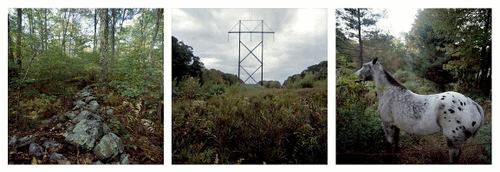
(Photo: Adam Ryder)
[CICADA HUM]
ROSA: It didn't actually occur to me that there is this excess energy escaping from these power lines that are actually making a constant electronic hiss all the time
[ELECTRICITY HUM]
SRISKANDARAJAH: These seemingly empty swatches of land are filled with sound.
ROSA: They make a loud buzzing sound
SRISKANDARAJAH: Maybe you have noticed some sort of sound too as you are driving by pole after pole after pole.
RYDER: They definitely provide a rhythm if you are driving past them on the highway, like if you are a commuter going past all these poles and they are evenly spaced.
[SOUND OF CARS PASSING]
RYDER: Spaced.
[SOUND OF CARS PASSING]
RYDER: Spaced.
[SOUND OF CARS PASSING]
RYDER: Yeah- they kind of create a visual rhythm as they travel along the state.
[SOUND OF CAR DRIVING, MUSIC]
SRISKANDARAJAH: Like a heartbeat. These pillars are more than just dead trees...they really have a life of their own. And as Brian and Adam continued to hike along the lines they saw that the land under and around the pylons is filled with a lot more than just sound.
ROSA: We were probably trespassing most of the time while we were there. There were a whole lot of other people doing that too - walking their dogs, riding their ATVs.
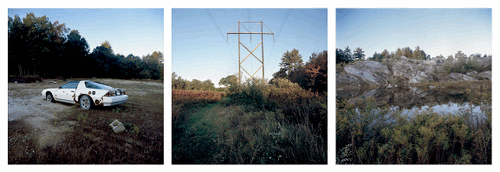
(Photo: Adam Ryder)
SRISKANDARAJAH: With a bit of amateur archeology Brian turned up even more.
ROSA: Just seeing a fire pit that someone made and a few rocks with a wooden board across them where someone was sitting and people would just go have fires and sit around and drink and be delinquent and it kind of made me think back to my teenage years a little bit.
SRISKANDARAJAH: The power lines carve out a space for people to meet - but Brian and Adam say they connect us in another way.
ROSA: By following these power lines which seemed to cut through disparate areas that aren't necessarily connected when looking from above you actually see that there is a continuum of rural to suburban to urban back to suburban to industrial and that they are all part of a vast network.
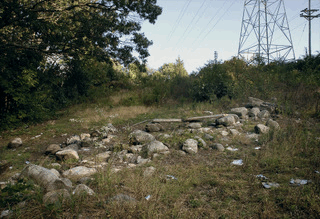
(Photo: Brian Rosa)
SRISKANDARAJAH: These are the power lines that bind. For Living on Earth I'm Ike Sriskandarajah.
[MUSIC: The Arcade Fire “In The Backseat” from “Funeral” (Merge Records 2004)]
Related link:
Power Line Project
Note on Emerging Science
GELLERMAN: Coming up, lovebirds, an unusual pairing. But first, love role reversal in this Note on Emerging Science from Alexandra Gutierrez.
[THEME]
GUTIERREZ: Female topi antelope don't like playing hard to get. They're not into prolonged courtship rituals, and they don't really like monogamy, either. In the battle of the sexes, these antelope essentially reverse the rules of engagement.
The standard assumption in sexual selection theory is that a male will aggressively pursue a female. But Finnish scientists observed that Topi behavior goes counter to that assumption. Researchers have noticed that female topis persistently – and sometimes violently – attempt to attract the best mate.
Because these females are only fertile for one day, they do not have the luxury of waiting for the best male to choose them, say the scientists. They must instead compete for the attention of the strongest males in order to improve their chances of getting pregnant. The fact that the males' sperm supply is limited further puts pressure on the females to find one good partner, or sometimes even a few.
While it could be argued that the topi males are in an enviable position, being such an object of desire can be tiring and even dangerous. Males will sometimes collapse from exhaustion as a result of this attention, and they must occasionally fight off females who can be a bit too domineering. So it seems that in the Topi world, love can hurt.
That's this week's note on Emerging Science. I'm Alexandra Gutierrez.
[THEME]
Woman's Best Friend
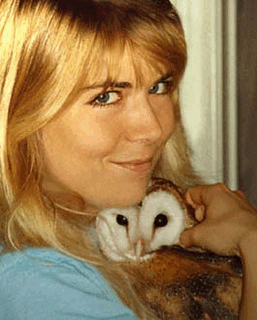
(Photo: Wendy Francisco)
GELLERMAN: Here's a sound only a mother could love.
[OWL SOUNDS]
GELLERMAN: A mother barn owl, that is.
[OWL SOUNDS CONTINUE]
GELLERMAN: Actually, it's also a sound Stacey O'Brien loves. Stacey O'Brien loves a barn owl. She's a wildlife biologist who adopted a baby barn owl named Wesley. For nineteen years, woman and bird shared an apartment, and a life, which Stacey O’Brien chronicles in her new book, "Wesley the Owl: The Remarkable Love Story of an Owl and his Girl." Hi, Stacey.
O'BRIEN: Hi.
GELLERMAN: Let me ask you to start with a reading from your book. Page 204 starts with "throughout our years together." You see it?
O'BRIEN: Yeah. "Throughout our years together, we had a cuddle ritual almost every night before bed. I would scoop him up with one hand cupped under his tummy, then cradle him in my left arm with his head resting in my hand.
One evening, however, as I was lying down and rubbing him under his wings, Wesley pushed with his feet, so that he was lying on my chest with his head up under my chin. Then, he rustled a bit, and slowly began to open both delicate golden wings, stretching them as far as they would go and laying then across my shoulders. He slept that way for a long time, and I stayed awake in awe."
GELLERMAN: A cuddling ritual.
O'BRIEN: Yes. Unheard of.
GELLERMAN: But you know, Stacey, I think some people hearing this would say "that's one strange bird" and they might not be talking about Wesley.
[LAUGHING]
O'BRIEN: Well, you know, in the wild, Wesley would have done that with his mate. And they're extremely affectionate in the wild. So he was doing what he would do in the wild naturally. So what I was trying to do was provide him with an experience as close to what would be natural as possible.
GELLERMAN: You were his surrogate. What was he to you?
O'BRIEN: He was my son. He was my baby. He was my little boy. But not in a condescending way. He was also my equal, because he was another species, another intelligent life form. And I respected his culture, and he respected mine.
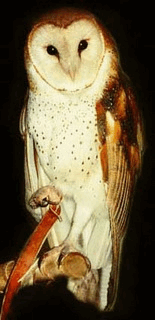
(Photo: Stacey O’Brien)
O'BRIEN: Yeah, he was just a little – about three or four days old, and a hiker found him apparently, down under a nest and brought him into Fish and Game. And when they find an unreleasable animal, they have a hard time placing it – any wild animal. Because all the facilities are pretty full. Zoos are full, rehab centers are full.
So sometimes they would bring owls like that to CalTech because we had the facilities. We had big, beautiful facilities for owls. But this guy needed to be raised like an infant. So they asked me to take over his care for the rest of his life, and I did. He moved in with me. So I put him in a little nesting box, and he went everywhere with me. Oh. It was hopeless. I was completely smitten.
GELLERMAN: Now, when I hear you talk about Wes, I'm wondering, are you projecting your emotions, human emotions onto this animal.
O'BRIEN: Well, you know, that's one thing that behavioral biologists used to worry about more than they do now. Of course, I have my own emotions about Wesley. But, I also knew a heck of a lot about barn owls already. So I knew what he would need. And in the wild, they can become very attached, first to their mother and then to their mate. So that was normal for him. He was very emotional about me. And for him to have a good experience of life, as he would in the wild, he needed an emotional connection, just like a human would.
GELLERMAN: Barn owls aren't pack animals, they're not members of a flock. They're loners and they do mate for life.
O'BRIEN: Yes. So there are some really specific problems that come with that. So we're used to the sort of social interactions where you would correct someone else, like a wolf will snap at another wolf and say, "stop that," you know? And the other wolf will understand that it's a correction.
But for an owl, a solitary animal, every animal in the wild, every animal in the world, except for their mate, is enemy. Owls are absolutely black and white. They don't change their minds. So I had to let him be exactly who he is and find a way to be with him in that context. So, it's very difficult to raise an owl.
GELLERMAN: There are a lot of myths about owls. There's one in France I saw, it says that an owl can help a woman find a husband.
[LAUGHING]
O'BRIEN: Well, it didn't work that way for me.
[LAUGHING]
GELLERMAN: No, I was going to say – you know, Wesley did just the opposite.
O'BRIEN: Yes he did.
GELLERMAN: He was jealous when you would bring a boyfriend in.
O'BRIEN: Well for one – in one way he was a good litmus test, because I was surprised that some guys were jealous of him and were threatened by him. And I thought that was so childish, you know. So, immediately they were out the door, you know. Forget it. I don't want this kind of childishness.
GELLERMAN: But my question is, was Wesley jealous of your boyfriends?
O'BRIEN: He seemed to accept that I had friends in my own species. It confused him. But he seemed to sense instantly if the guy didn't like him. Again, anything that seemed aggressive, he thought was a threat on my life too.
GELLERMAN: What did you think? You say he was your son.
O'BRIEN: Yeah, I didn't see him as a mate, of course. I'm a regular human being.
[LAUGHING]
O'BRIEN: You know, I don't look to a bird for ....
[LAUGHING]
GELLERMAN: You recorded Wesley, right?
O'BRIEN: Yes, I put a lot of effort into trying to record his various sounds. When he decided to make me his mate, he started up with this rocking the house, extremely loud sound, that just vibrated the walls. Eventually, I was able to get that on tape because he did it every single day from then on. It was his way of calling me to come spend time with him. Would you like to hear it?
[WESLEY'S CALL]
GELLERMAN: Oh yeah, sure.
[CALL CONTINUES]
O'BRIEN: That is his nesting call. He's trying to call me. And boy, you know, that's a loud sound. It rockets out through the forests and out through the canyons. And if he doesn't have a mate, it will call a female to him. So it serves a dual purpose.
If he has a mate, she'll come to be with him. If he doesn't have a mate, he will find one that way. And he found many, many females that way that came directly to our bedroom window and hovered at the bedroom window looking in to see if he was a lone owl or mated owl.
GELLERMAN: So, Stacey, what was your response?
O'BRIEN: I would go to him because the sound was so loud.
GELLERMAN: You didn't chirp back, did you?
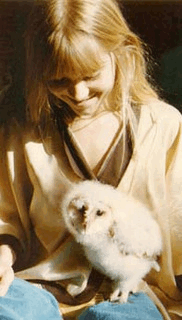
(Photo: Wendy Francisco)
And they were specific for certain things like one meant he wanted – he was begging for a magazine. He liked to rip up magazines. Another one meant he was begging for water. So, anyways, he developed his own language system, and he made that leap across from understanding what I was doing with symbolic language, I think, to creating his own symbolic language, with his own owl sounds.
GELLERMAN: I know that you brought another sound with you. What is that?
O'BRIEN: This is a sound that, when I recorded it, it had never been recorded by a biologist or noted by a biologist, and it was Wesley's mating sound, when he was mating. Not the mating call to bring a mate, but the sound he made when he was actually mating with me.
[WESLEY'S MATING SOUND]
GELLERMAN: I gotta ask you, Stacey, when he was giving his mating call, what were you doing?
O'BRIEN: You mean when he was mating with me?
GELLERMAN: Yeah.
O'BRIEN: Aacch, well there was no hope. I mean, it – and this is – I've talked to other people who have an imprinted bird with the same problem – you cannot, you cannot fight them off. I mean, if they want to mate with – they'll pick a place on like your hat or they'll – or your shoulder.
With me, if was my arm that he thought was the spot. So, if try to fight them off, they just become more and more aggressive. So, you really, you have to sort of just let them do their thing and get over it, and move on with your day.
[LAUGHING]
GELLERMAN: We're not giving the book away if we say that Wes dies after 19 years. What now? Is there another owl in your life?
O'BRIEN: I would like there to be. That's my goal, really. But I would require another permit, because my permit was just for Wesley, for one owl.
GELLERMAN: Stacey, as I was reading your book I’m thinking, is this woman nuts?
O'BRIEN: Oh no.
[LAUGHING]
GELLERMAN: Well, and then – as I'm reading the book, I come to kind of understand this unique relationship.
O'BRIEN: Really? Oh good, well I'm glad you understood it because I don't want to come off like a strange bird. Because I'm perfectly normal. I mean – well – that's why I put the day in the life of a biologist in there. This is not even that wild, you know, compared to the monkey guy or the spider guy or the guy with the parasites in his skin, you know? I didn't have parasites in my skin. I thought I was doing pretty good.
[LAUGHING]
GELLERMAN: Well Stacey, I really enjoyed talking with you. Thank you very much.
O'BRIEN: Thank you.
GELLERMAN: Stacey O'Brien's new book is called "Wesley the Owl: The Remarkable Love Story of an Owl and His Girl."
Related link:
To learn more about Stacey and Wesley, click here.
[MUSIC: Andy John “Hoot Owl Boogie” from “Toy Chest Boogie” (Recall Records 2008)]
[SOUND OF WATER]
GELLERMAN: We leave you this week with a little bit of splish-splash...
[SOUND OF MOOSE COMING OF THE WATER]
GELLERMAN: On a cool July morning, three moose frolic in the waters of a Wasatch Mountain lake in Utah. Here a large female urges her two young moose to follow her lead and they slowly emerge from the water.
Jeff Rice eavesdropped on the bathing beauties and recorded them for the University of Utah Marriott Library, westernsoundscape.org.
[MOOSE, WATER SOUNDS]
Living on Earth is produced by the World Media Foundation. Our crew includes Bobby Bascomb, Eileen Bolinsky, Ingrid Lobet, Helen Palmer, Jessica Ilyse Smith, Ike Sriskandarajah, Mitra Taj and Jeff Young, with help from Sarah Calkins, Marilyn Govoni and Sammy Souza. Our interns are Annie Glausser and Lisa Song. Jeff Turton is our technical director. This show was engineered by Dana Chisholm. Alison Lirish Dean composed our themes. Our executive producer is Steve Curwood. You can find us anytime at loe.org. I'm Bruce Gellerman. Thanks for listening.
Living on Earth wants to hear from you!
Living on Earth
62 Calef Highway, Suite 212
Lee, NH 03861
Telephone: 617-287-4121
E-mail: comments@loe.org
Newsletter [Click here]
Donate to Living on Earth!
Living on Earth is an independent media program and relies entirely on contributions from listeners and institutions supporting public service. Please donate now to preserve an independent environmental voice.
NewsletterLiving on Earth offers a weekly delivery of the show's rundown to your mailbox. Sign up for our newsletter today!
 Sailors For The Sea: Be the change you want to sea.
Sailors For The Sea: Be the change you want to sea.
 The Grantham Foundation for the Protection of the Environment: Committed to protecting and improving the health of the global environment.
The Grantham Foundation for the Protection of the Environment: Committed to protecting and improving the health of the global environment.
 Contribute to Living on Earth and receive, as our gift to you, an archival print of one of Mark Seth Lender's extraordinary wildlife photographs. Follow the link to see Mark's current collection of photographs.
Contribute to Living on Earth and receive, as our gift to you, an archival print of one of Mark Seth Lender's extraordinary wildlife photographs. Follow the link to see Mark's current collection of photographs.
 Buy a signed copy of Mark Seth Lender's book Smeagull the Seagull & support Living on Earth
Buy a signed copy of Mark Seth Lender's book Smeagull the Seagull & support Living on Earth

